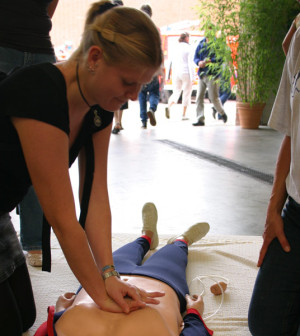- Skip Storing This Everyday Product in the Fridge Door
- Green Tea + B3 Pairing May Boost Brain Health
- Navigating Your Midlife Crisis: Embracing New Possibilities
- City Raccoons Showing Signs of Domestication
- Mapping the Exposome: Science Broadens Focus to Environmental Disease Triggers
- One Week Less on Social Media Linked to Better Mental Health
- Your Brain Changes in Stages as You Age, Study Finds
- Some Suicide Victims Show No Typical Warning Signs, Study Finds
- ByHeart Formula Faces Lawsuits After Babies Sickened With Botulism
- Switch to Vegan Diet Could Cut Your Greenhouse Gas Emissions in Half
Restoring Blood Flow Beats Exercise for Poor Leg Circulation

For people with poor circulation in their leg arteries, a medical procedure to restore blood flow may have greater benefits than exercise, preliminary research suggests.
People with peripheral artery disease (PAD) experience pain and fatigue while walking. These symptoms develop because poor circulation in the arteries that supply blood to the limbs causes damage and scarring in the muscles, the researchers explained.
There is currently no way to reverse the scarring associated with PAD. But a procedure to reopen or bypass blockages in the blood vessels and restore blood flow to the limbs — also known as revascularization — prevents it from getting worse, the researchers said.
For the study, the researchers analyzed levels of a protein, called TGF-Beta1, that triggers scarring in patients with severe PAD. The investigators also measured levels of collagen, which is the protein found in scars, in biopsies of the patients’ calf muscles.
After six months, the researchers compared the biopsy results among 20 patients who underwent procedures to restore blood flow, 19 patients who completed a supervised exercise program, and 17 who had no treatment (the “control” group).
Neither of the treatment groups saw a reduction in scarring associated with PAD, but procedures to restore blood flow stopped it from getting worse, the findings showed.
The study also found that collagen fibers and TGF-Beta1 levels increased in the exercise and control groups. Levels of these proteins, however, did not increase in the revascularization group.
“This suggests that the long-term benefits to the health of leg muscles is better with revascularization than with exercise therapy alone,” study author Duy Ha said in a news release from the American Heart Association. Ha is a doctoral candidate in cellular and integrative physiology at the University of Nebraska Medical Center in Omaha.
“Unfortunately, not all patients are candidates for these procedures, which carry significant risks, and the treated vessels may get blocked again,” Ha added.
The study authors reported that patients in both treatment groups saw improvements in how long they could walk on a treadmill before their pain forced them to stop. However, only those in the revascularization group improved the distance they could walk within six minutes.
“We hope that we can develop therapies that directly decrease TGF-Beta1 and its associated scarring in the leg muscles of PAD patients. Such new treatments, when used alone or along with revascularization and exercise, may maintain or enhance the ability of our patients to walk and live healthy lives,” Ha said.
The findings were to be presented Thursday at the annual meeting of the American Heart Association, in Nashville, Tenn. Findings presented at meetings are generally viewed as preliminary until published in a peer-reviewed journal.
More information
The U.S. National Institutes of Health has more about PAD treatment.
Source: HealthDay
Copyright © 2025 HealthDay. All rights reserved.










